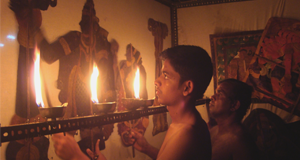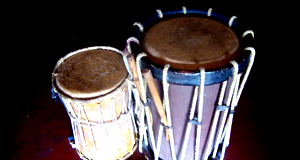Tholpava koothu is believed to have originated the 9th or 10th century A.D. this traditional puppet play of Kerala state is still being conducted annually in so many considered as a temple festival and it will last from 7days to 14,21,41,71 days .without any break according to the temple customs prevailing in each temple for 6 to 8 hours .the show start 10pm every night and will be continued till 5.30am. All theatres are being constructed adjacent to the temple of the goddess Bhadra kali. It is believed that the goddess will be pleased to watch the show and bless the devotes. This Tolpavakoothu is completely based on “Kamba Ramayana “and the language used in its performance is also Tamil. The fight between Sree Rama and Ravana and the fight between Bhadra kali and Darikasura (demon king) took place at the same time. And hence the goddess Bhadra kali could not see the war between Sree Rama and Ravana this was brought to the notice of lord Shiva in turn told her to go the earth and remain in temples. Being in the puppet show in which the fight between Sree Rama and Ravana will be shown.
Koothu Madam or Puppet theatre – The Stage

These are permanent high stages for the conduct of the show in all the Bhagvati temples. It is known as “Koothu Madam” meaning shadow play theatre. usually the length of “Koothu Madam” will be 42 feet and 8 feet in there will be curtain through out in front of the madam and the puppet show behind will conduct the shadow play with the help of burning oil wick lamps . Usually the curtain should face the deity of the temples. The upper portion of the curtain will be white in color and the lower part will be black. Puppets are held or mobilized between the lamps and the curtain so as to develop the sharp shadows on the curtain. The puppets are fixed on the screen. It is done using thorns of a native plant, The stage Kerala had over 200 puppet theatres in the past days. We still pre serve about 90 theatres for one to come out as an expert puppeteer. One has to go through a rigorous training of nearly 15 years.
The nights become alive with the shadow characters, music and drama in the Koothumadam. Koothumadam is the permanent theater where this are form is performed. Koothumadams are found in Kali (Bhadra Kali) temples in and around Palakkad district of Kerala.
There are more than 50 theaters in Kerala adjoining the temples where this art form is performed for a minimum of 7nights to a maximum of 41 to 60 nights. The show starts around 10pm and lasts till 5am in the morning.
The Koothumadam at the Aryankavu Bhagavathi temple at Koonathara region in Palakkad is very famous for its existance. Here the show lasts for 21 nights in adjacent to the Pooram festival which falls normally on 4th or 5th of April every year.
The play is organized in such a way that the story of Rama from his birth to the Pattabhishekam (the crowning ceremony) is performed with the Rama Ravana yudha which is the important part of the play.
There is a belief that Goddess Kali could not see Rama Ravana War since she was engaged in war with Darika. That is why the story of Rama Ravana yudha is presented to the Goddess in the form of Tholpavakoothu.
The movie theaters project the images from a small film on a big screen where the colorful image is displayed on the screen. This all started from the ancient man’s imagination of projecting the image on the screen with a perforated opaque object and a source of light from the behind.
It is really interesting to find that the very first form of cinema is still presented in the form of shadow puppets in many parts of the world as a traditional art form.
In India particularly, there are many forms of Shadow Puppets plays. The one which is practiced particularly in Kerala is known as Tholpavakoothu. Thol – means leather, Pava – means puppet and Koothu – means play.
At present Tholpavakoothu is performed as an offering to the Goddess Kali (Bhagavathi) in the temples in and around Palakkad district especially Valluvanad. There are more than 90 koothu madams (Permanent Theaters ) which are the venues where this artform is performed in coincidence with the yearly festival of the temples.
ILLUMINATION

On the wooden beam –vilaku madam –behind the curtain are placed 21 lighted lamps equidistant from each other. Husked coconuts cut in halves serve as lamps, half filled with coconut oil and provided with cotton wicks .set in row from one end of the stage to the other ,they illumine the screen –ayapudava-uniformly.
In a few temples however, cressets –chiratu-made of clay have been used instead. Cresset lamps, with an upper and lower compartment, are specially made for tolpvavkoothu. The upper cresset is the lamp prpper;oil is poured in to it and the wick lighted . The lower compartment has holes through water is poured, which prevents the clay lamp from getting over heated.
MUSICAL INSTRUMENTS

The chief accompaniments for tholpavakoothu are drum-Ezhupara , madahalam, kuzhal, Ilathalam, conch, chilanka
To add to the dramatic impart of certain scenes the aristes produce special sound effects and also recite Vaitaris- rhythamic syllables. A fight scene is accented by cries of Sapai Sapai from behind the stage.
The performance is accompanied by the recitation of slokas and the performers are required to learn over 3000 of these before they perform. The recitation is accompanied by instruments such as chenda, maddalam, ezhupara, ilathalam, conch and cherukuzhal.

